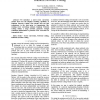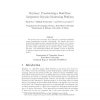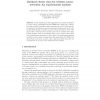ADHOCNETS
2009
Springer
14 years 6 months ago
2009
Springer
Topology control is the problem of assigning powers to the nodes of an ad hoc network so as to create a specified network topology while minimizing the energy consumed by the netw...
ADHOCNETS
2009
Springer
14 years 6 months ago
2009
Springer
Abstract. This paper proposes a way to incorporate multimedia traffic in a real-time wireless communication network without jeopardizing the hard real-time traffic. This idea has ...
ADHOCNETS
2009
Springer
14 years 6 months ago
2009
Springer
Although IEEE 802.15.4 is being considered as a promising standard for low-cost low-power Wireless Sensor Networks (WSNs), several issues in the specification are still open. One o...
ADHOCNETS
2009
Springer
14 years 6 months ago
2009
Springer
—We introduce a novel error correction scheme that uses the implicit encoding capability of Random Network Coding. This scheme does not add redundancy to the data prior to transm...
ADHOCNETS
2009
Springer
14 years 6 months ago
2009
Springer
We present a low-cost sensor buoy designed for unattended dissolved oxygen measurement in aquatic environment. We describe the buoy’s architectural design and three experiments ...
ADHOCNETS
2009
Springer
14 years 6 months ago
2009
Springer
Abstract. Existing localization techniques such as GPS have fundamental limitations which preclude deployment in urban canyons or areas with inconsistent network availability. Augm...
ADHOCNETS
2009
Springer
14 years 6 months ago
2009
Springer
Abstract. Wireless sensor networks are vulnerable to the node clone attack because of low-cost, resource-constrained sensor nodes, and uncontrolled environments where they are left...
ADHOCNETS
2009
Springer
14 years 6 months ago
2009
Springer
Self-organisation has emerged as a very promising approach to the design, deployment, operation, control and evolution of complex wireless networks. The dominant strictly layered d...
ADHOCNETS
2009
Springer
14 years 6 months ago
2009
Springer
Abstract. This paper addresses the detection and reporting of abnormal building access with a wireless sensor network. A common office room, offering space for two working persons...
ADHOCNETS
2009
Springer
14 years 6 months ago
2009
Springer
Node clustering and data aggregation are popular techniques to reduce energy consumption in large WSNs and a large body of literature has emerged describing various clustering prot...



